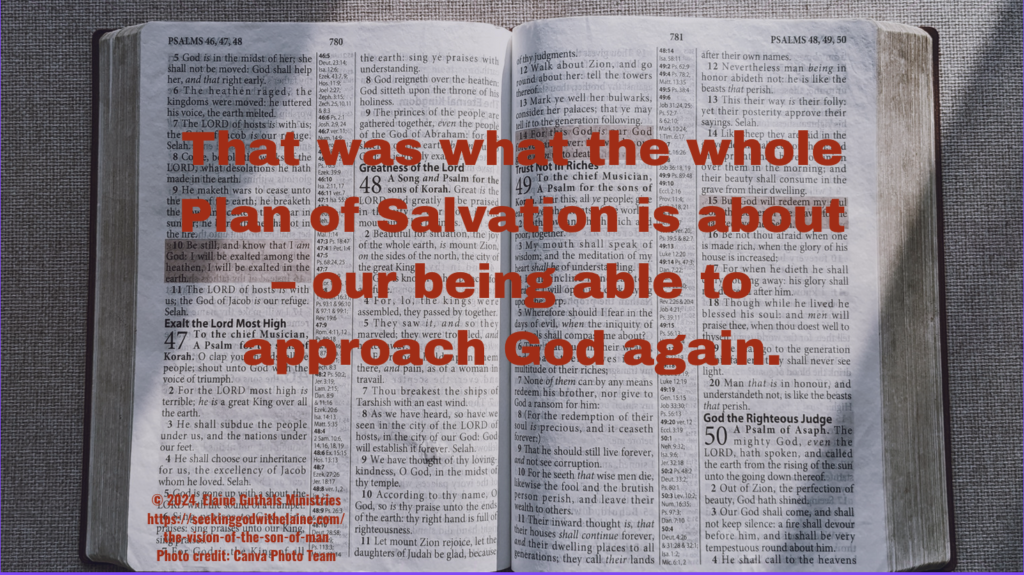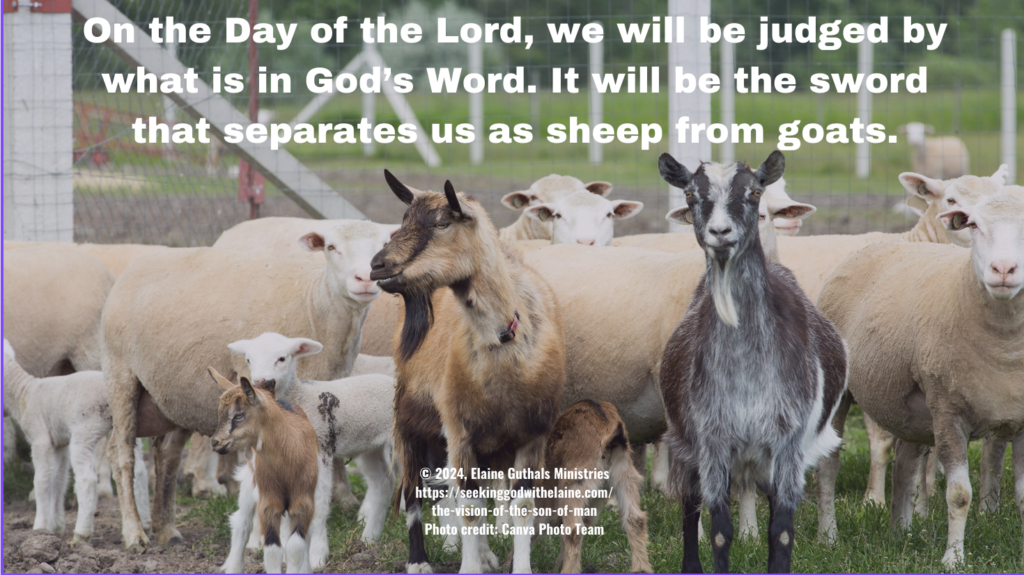John described the appearance of the Man in his vision. This devotional reading looks at terms that describe this Man as Jesus and terms that describe this Man as God.
Nuggets
- John did not call the Person in the vision by name.
- The Person described could either have been God or Jesus.
- God’s Word is a sword.
- We are to seek God.

John was on the island of Patmos. One Sunday, he had a vision. In the last devotion, we talked about John hearing a voice speaking to him.
In this devotion, John turned around and saw a vision. What – or more importantly – Who did he see?
Let's Put It into Context
To read devotions in the On the Day of the Lord theme, click the button below.
Devotions in the John’s First Vision series
Like a Son of Man
“Then I turned to see the voice that was speaking to me, and on turning I saw seven golden lampstands, and in the midst of the lampstands one like a son of man ...” (Rev. 1: 12-13 ESV)
John did not call the Person in the vision by name.
We’re going to save discussion of the lamp stands and stars to verse 20. At this point, we are going to focus on the Man in the vision.
In it, we read this to be that John recognized, as the English Standard Version translates it, a son of man. This could be anyone.
The King James Version translates it as “… the Son of man …” (Rev. 1: 13 ESV). This identifies Him as Jesus, with Whom he had spent three years of His life.
But John didn’t call Him Jesus. He gave no name whatsoever.
Now starts a big confusion. I had always been told that the Man in the vision was Jesus. But was it Jesus?
Let’s apply good language skills here. God had been talking. “’I am the Alpha and the Omega,’ says the Lord God, ‘who is and who was and who is to come, the Almighty’” (Rev. 1: 8 ESV).
Had John moved on to something else? Do we need to take the description on its own merit? But that leads to confusion, too.
John said the voice heard was “… a loud voice like a trumpet” (Rev. 1: 10 ESV). Only God has been described having a trumpet voice. “Cry aloud; do not hold back; lift up your voice like a trumpet; declare to my people their transgression, to the house of Jacob their sins” (Isa. 58: 1 ESV).
So, this is the conundrum. Jesus never was characterized as having a voice as a trumpet, but God never used the title Son of Man.
But, Jesus was a likeness of man, wasn’t He? He was 100% man with sinful flesh, but He was also 100% the identity of God. “But emptied himself, by taking the form of a servant, being born in the likeness of men” (Phil. 2: 7 ESV).
Yes, Jesus was also human, but He was more. So, the Jesus John had known was like a man.
Why didn’t John just call Jesus by name if it was Him?
It was probably because John could have been seeing the glorified Jesus. He had been one of the few to see the Son of God glorified. His appearance may have been like it was on the Mount of Transfiguration. But again, why didn’t he call Jesus by name?
I would say it was more than what John had seen here on earth. He was seeing the exalted Christ as he never had because he had seen Jesus pre-ascension without His glory. Now, He is seeing Him in all His glory – if it is Jesus.
Think about it. What if it is God Himself? God is so concerned that we understand the end times as much as we are supposed to that He may have come Himself to tell us. We’ve already said in Revelation 1: 1 that the message of Revelation was from God.

Truth be told, either One could be the One in the vision. I don’t think it is our place to try to understand. If we were supposed to know, we would have been told.
So, I am just going to call Him the Vision Man, and let God worry about the rest. If it was God Himself or if it was Jesus, Vision Man was there under the authority of God because the message was from God.
What? This is another thing that we may not have gotten exactly right? Put it in the UNR book – understanding not relevant.
Vision Man’s Appearance
“... clothed with a long robe and with a golden sash around his chest. The hairs of his head were white, like white wool, like snow. His eyes were like a flame of fire, his feet were like burnished bronze, refined in a furnace, and his voice was like the roar of many waters” (Rev. 1: 13-15 ESV)
The Person described could either have been God or Jesus.
No, it isn’t strange that clothing is discussed. When we are reading a book, how often is a character’s clothing described? Like, every time you meet a new character and then every time it changes.
There is precedence of talking about clothing in visions. Daniel did. “I lifted up my eyes and looked, and behold, a man clothed in linen, with a belt of fine gold from Uphaz around his waist” (Dan. 10: 5 ESV).
But was a long robe the usual fashion choice for a Jewish man? A robe, however, was the garment for a priest. “These are the garments that they shall make: a breastpiece, an ephod, a robe, a coat of checker work, a turban, and a sash. They shall make holy garments for Aaron your brother and his sons to serve me as priests” (Ex. 28: 4 ESV).
Well, isn’t Jesus our High Priest? “Since then we have a great high priest who has passed through the heavens, Jesus, the Son of God, let us hold fast our confession. For we do not have a high priest who is unable to sympathize with our weaknesses, but one who in every respect has been tempted as we are, yet without sin. Let us then with confidence draw near to the throne of grace, that we may receive mercy and find grace to help in time of need” (Heb. 4: 14-16 ESV).
That would tip the scale of Vision Man to being Jesus.
Taking that a step further, it is important that we be clothed with the same garments. “I will greatly rejoice in the LORD; my soul shall exult in my God, for he has clothed me with the garments of salvation; he has covered me with the robe of righteousness, as a bridegroom decks himself like a priest with a beautiful headdress, and as a bride adorns herself with her jewels” (Isa. 61: 10 ESV).
The rest of the characteristics used to describe Vision Man had previously only been used to describe God.
- Hair: “As I looked, thrones were placed, and the Ancient of Days took his seat; his clothing was white as snow, and the hair of his head like pure wool; his throne was fiery flames; its wheels were burning fire” (Dan. 7: 9 ESV).
- Eyes, feet, and voice: “His body was like beryl, his face like the appearance of lightning, his eyes like flaming torches, his arms and legs like the gleam of burnished bronze, and the sound of his words like the sound of a multitude” (Dan. 10: 6 ESV).
- Fire: “Therefore let us be grateful for receiving a kingdom that cannot be shaken, and thus let us offer to God acceptable worship, with reverence and awe, for our God is a consuming fire” (Heb. 12: 28-29 ESV).
- Voice: “And behold, the glory of the God of Israel was coming from the east. And the sound of his coming was like the sound of many waters, and the earth shone with his glory” (Ezek. 43: 2 ESV).
The white hair represents Their age and eternal nature. Their eyes are all-seeing, aiding Him in being all-knowing.
Jesus used His feet to unwaveringly forward His mission. But it also had stability because it is following God’s plan. Even more, can we see the power and endurance that identifies?
The rushing waters are majestic. “And behold, the glory of the God of Israel was coming from the east. And the sound of his coming was like the sound of many waters, and the earth shone with his glory” (Ezek. 43: 2 ESV). His shout will have to be majestic for the whole universe to hear.
Regardless if it is Jesus or God, the description of Vision Man is a little bit scary, isn’t it? All of the fire and lightening doesn’t seem to make Him approachable.
But They are.
- “Let us then with confidence draw near to the throne of grace, that we may receive mercy and find grace to help in time of need” (Heb. 4: 16 ESV).
- “You will seek me and find me, when you seek me with all your heart” (Jer. 29: 13 ESV).
That was what the whole Plan of Salvation is about – our being able to approach God again. The only way we can do that is to restore our relationship with Him through admitting we are sinners, believing in Jesus, and confessing Him as Sovereign God.

The Sword
“In his right hand he held seven stars, from his mouth came a sharp two-edged sword …” (Rev. 1: 16 ESV)
God’s Word is a sword.
God’s Word talks about having a two-edged or double-edged sword. “For the word of God is living and active, sharper than any two-edged sword, piercing to the division of soul and of spirit, of joints and of marrow, and discerning the thoughts and intentions of the heart” (Heb. 4: 12 ESV).
Thompson told us the purpose of having two edges. One edge of the sword is for convicting us to become God’s children and correcting us to sanctify us.
The other edge is to protect us from Satan. Taylor explained how. It is to be used “For repelling Satan’s temptations” and “For actually destroying Satan’s works.” That is the only way we are going to defeat Satan — leaving it to God.
Resources
It really makes sense when we connect Hebrews 4: 12 with Ephesians 6: 17. “And take the helmet of salvation, and the sword of the Spirit, which is the word of God” (Eph. 6: 17 ESV).
On the Day of the Lord, we will be judged by what is in God’s Word. It will be the sword that separates us as sheep from goats.

Let’s let John put this another way. “In the beginning was the Word, and the Word was with God, and the Word was God” (Jn. 1: 1 ESV).
What was Jesus’ mission here on earth? It was to give us the gospel.
What is the gospel about? Salvation only found through belief in Jesus. “And there is salvation in no one else, for there is no other name under heaven given among men by which we must be saved” (Ac. 4: 12 ESV).
Jesus and the salvation He brings is the message of the gospel, written out in God’s Word.
Remember from where God’s Word came. “All Scripture is breathed out by God and profitable for teaching, for reproof, for correction, and for training in righteousness, that the man of God may be complete, equipped for every good work” (II Tim. 3: 16-17 ESV).
How do we use it? Just as a sword must be drawn out of the sheath to be used, we must pick God’s Word up off the table or shelf and read it.

Oh, yes. We are supposed to memorize it and know it.
But that doesn’t mean we never read it again. God will continue to reveal Himself to us as we read new passages and reread what we have already read.
If we have problems reading God’s Word, we have problems being a disciple — being a Christian. If we have trouble studying it, ditto.
If we have problems getting God’s Word into our hearts, we aren’t Christians.
Shining Face
“… and his face was like the sun shining in full strength” (Rev. 1: 16 ESV)
We are to seek God.
Let’s look at Vision Man as God first. No, we can’t see God and live while we are in these physical bodies. “‘But,’ he said, ‘you cannot see my face, for man shall not see me and live’” (Ex. 33: 20 ESV).
I know. I know. There are some conflicting verses about this. “Thus the Lord used to speak to Moses face to face, as a man speaks to his friend. …” (Ex. 33: 11 ESV)
But we can see the face of God. “You have said, ‘Seek my face.’ My heart says to you, ‘Your face, Lord, do I seek’” (Ps. 27: 8 ESV).
Let’s wade through that.
God is Spirit, so He doesn’t necessarily have human characteristics – face, hands, eyes, emotions, etc. But we attribute those to Him to help us understand Him.
What God truly looks like is one for the UNR book – understanding not relevant. We’ll find out on the Day of the Lord, if not Christ’s Second Coming.
Bible teachers have long tried to find ways to describe what God’s face is. Most compare it to the sun.
I can see that. We can’t touch the sun, but we all can see it. We know it is still there even if we don’t see it because of darkness of night or cloud cover.
Let’s look at it this way. God’s “face” is His personality — and I am not sure that is exactly the correct word. It is another attempt to describe Him in human terms so we can understand.
God makes it personal. We aren’t supposed to fear Him – feel terror. We are supposed to fear Him – feel awe.
We don’t want God to turn away from us, especially in anger. Bad things happen when He does.
When God takes His presence away, it is because of our doing.
- “The face of the LORD is against those who do evil, to cut off the memory of them from the earth” (Ps. 34: 16 ESV).
- “You who are of purer eyes than to see evil and cannot look at wrong …” (Hab. 1: 13 ESV).
We only have to repent and ask to be restored to God’s presence. “Ask, and it will be given to you; seek, and you will find; knock, and it will be opened to you. For everyone who asks receives, and the one who seeks finds, and to the one who knocks it will be opened” (Mt. 7: 7-8 ESV).
If we look at Vision Man as Jesus, people have seen His face before. He had a face and knew how to use it. “When the days drew near for him to be taken up, he set his face to go to Jerusalem” (Lk. 9: 51 ESV).
Making the Connections
Why did John – and we – get a vision? Think of it.
Our Savior comes to see us. But is it Jesus, God, or a representation?
Either way, Jesus is a representation of God.
How Do We Apply This?
- Utilize reading God’s Word as a weapon against Satan.
- Use God’s Word to grow spiritually.
- Give God’s Word the reverence it deserves.
- Use reading God’s Word to jumpstart our prayer life when we feel it is lacking.
- Find God’s power to be used in us in God’s Word.
- Use God’s Word to witness to others.
- Evaluate where we are at on the Sanctification Road by God’s Word.
- Put our hope in Christ.
- Embrace Jesus as our High Priest.
Resources
Father God. Whoever appeared to John that day in Patmos, thank You for sending John the vision. Thank You for loving us enough to come to us. Thank You for letting us seek Your face. Amen.
What do you think?
Leave me a comment below (about this or anything else) or head over to my Facebook group for some interactive discussion.
If you don’t understand something and would like further clarification, please contact me.
If you have not signed up for the email providing the link to the devotions and the newsletter, do so below.
If God has used this devotion to speak with you, consider sharing it on social media.